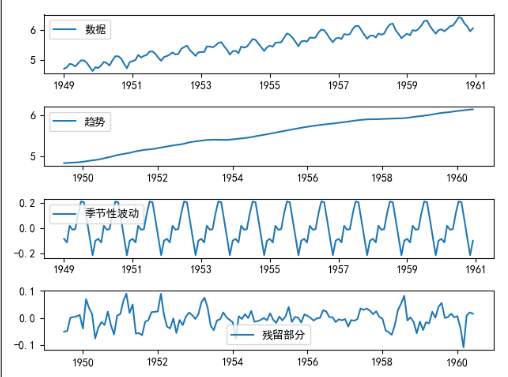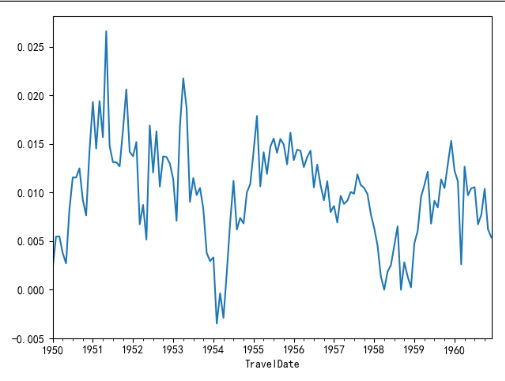1.继续使用statsmodels作为计算库
上一篇已经说了下一步要干什么,这里直接给代码
def decompose(timeserise):
decomposition = seasonal_decompose(timeserise)
# 趋势
trend = decomposition.trend
# 季节性
seasonal = decomposition.seasonal
# 残留部分
residual = decomposition.resid
# 成分分解绘图部分
plt.subplot(411)
plt.plot(ts_log, label="数据")
plt.legend(loc='best')
plt.subplot(412)
plt.plot(trend, label="趋势")
plt.legend(loc='best')
plt.subplot(413)
plt.plot(seasonal, label="季节性波动")
plt.legend(loc='best')
plt.subplot(414)
plt.plot(residual, label="残留部分")
plt.legend(loc='best')
plt.tight_layout()
plt.show()
return trend, seasonal, residual
if __name__ == '__main__':
draw_rend(ts, 12)
res = teststationayity(ts)
print(res)
# 数据对数变换 为了df平稳性校验
ts_log = np.log(ts)
draw_moving(ts_log, 12)
# 分解图
trend, seasonal, residual = decompose(ts_log)
#参数整理
print("#############")
rol_mean=ts_log.rolling(window=12).mean()
rol_mean.dropna(inplace=True)#drop掉nan
ts_diff_1=rol_mean.diff(1)
ts_diff_1.dropna(inplace=True)
(1)分解图

(2)一阶差分

2.再次df检验
复用上次代码
res2=teststationayity(ts_diff_1)
print(res2)
得到返回值:
Test Statistic 0.815369
p_value 0.991880
#Lags Used 13.000000
Number of Observation Uesd 130.000000
Critical Value(1%) -3.481682
Critical Value(5%) -2.884042
Critical Value(10%) -2.578770
dtype: float64
######对比线#######
Test Statistic -2.709577
p_value 0.072396
#Lags Used 12.000000
Number of Observation Uesd 119.000000
Critical Value(1%) -3.486535
Critical Value(5%) -2.886151
Critical Value(10%) -2.579896
dtype: float64
这里可明显看到p值在数据处理后趋于0,统计值回落到%5~%10。
2020-06-01